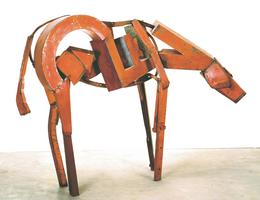 Deborah
Butterfield's famous horse sculptures - 16 of which are currently
being exhibited at the Figge Art Museum - are created from gathered
steel or bronze or wood and formed into horses of great beauty and
spirit. There is an elemental surprise that her horses are made this
way - abstract and yet real, freely formed and yet completely
descriptive. Her sculptures become living, breathing creatures before
our senses, expressing the horses' strength and power and also their
delicacy and silence. They will remain on the third and fourth floors
of the Figge through May 27.
Deborah
Butterfield's famous horse sculptures - 16 of which are currently
being exhibited at the Figge Art Museum - are created from gathered
steel or bronze or wood and formed into horses of great beauty and
spirit. There is an elemental surprise that her horses are made this
way - abstract and yet real, freely formed and yet completely
descriptive. Her sculptures become living, breathing creatures before
our senses, expressing the horses' strength and power and also their
delicacy and silence. They will remain on the third and fourth floors
of the Figge through May 27.
For more than two decades Butterfield has been making these assembled figures, combining her early training in ceramics and sculpture with her long love and knowledge of horses.
She lives and creates in her studio in Hawaii and on her horse ranch in Montana, where she also trains her many horses in the dance of dressage. She has even won a national gold medal in this sport.
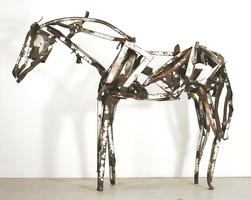 All
of her work has the same format, with the horses either standing
still or lying down. But like a portrait artist capturing an
individual sitter, Butterfield makes each animal unique. Her style
has evolved over the years to a cleaner, less-hidden view of the
individual horse. Her earlier work seems to be more a vehicle for a
self-portrait; now she is forgetting herself in her work and is
clearly focused on capturing each horse.
All
of her work has the same format, with the horses either standing
still or lying down. But like a portrait artist capturing an
individual sitter, Butterfield makes each animal unique. Her style
has evolved over the years to a cleaner, less-hidden view of the
individual horse. Her earlier work seems to be more a vehicle for a
self-portrait; now she is forgetting herself in her work and is
clearly focused on capturing each horse.
The announcement postcard for the exhibition shows a metal horse named Rondo, made of found steel and welded together. Old curved forms of antique car parts and fenders swirl around his hindquarters. Another swirl of rusted metal describes his interior, and a hammered scrap of metal defines his shoulder. Shredded metal expresses his neck and jaw, and a long, thin ribbon of iron curves over his back and down to his mouth. There are empty, undefined spaces in his body and legs. These voids give the eye relief from the rust-brown surfaces, and allow us to see through the horse, like an opening for the wind to blow through or the spaces between the notes of music. We sense the horse standing quietly, enduring the rain, or waiting to be saddled. His long tail hangs.
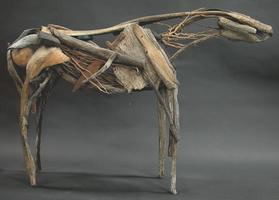 It
is difficult to say how we understand the horse's character. Asking
the artist, she said that portraying the horse is an intuitive
ability on her part, knowing when a flank was correct, or the nose
too long, or the head just right. Beyond the technical craft, she
said, a deep empathy exists between the animal and the artist, which
allows her to represent them so well.
It
is difficult to say how we understand the horse's character. Asking
the artist, she said that portraying the horse is an intuitive
ability on her part, knowing when a flank was correct, or the nose
too long, or the head just right. Beyond the technical craft, she
said, a deep empathy exists between the animal and the artist, which
allows her to represent them so well.
But rather than simply stating what an individual horse looks like by counting the ribs or measuring the distance from the hoof to the fetlock, she has suggested horses from the inside out, revealing their individual spirits and presences through her strong forms. A young visitor to the exhibit told me, "First you see the horses, and then you see how they're made."
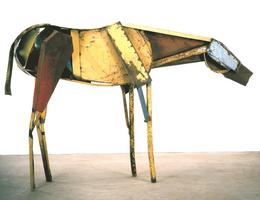 She
works with found scraps of metal retrieved from old junkyards. She
said that she has accumulated more than 200 tons of metal that lies
in piles around her studios on pallets of various colors. She
attaches these pieces onto a standard bronze armature, then adds and
subtracts and hammers and welds segments of rusted and painted metal
together, leaving many negative spaces. Her forms come together
"sometimes just flying on," she said, into self-contained,
mystical, and tangible horses, as real and alive as any horse we have
seen.
She
works with found scraps of metal retrieved from old junkyards. She
said that she has accumulated more than 200 tons of metal that lies
in piles around her studios on pallets of various colors. She
attaches these pieces onto a standard bronze armature, then adds and
subtracts and hammers and welds segments of rusted and painted metal
together, leaving many negative spaces. Her forms come together
"sometimes just flying on," she said, into self-contained,
mystical, and tangible horses, as real and alive as any horse we have
seen.
Forgetting the Other is a nine-foot-tall horse of red and white painted metal, a massive figure with a great curving neck, long, powerful legs, and a long nose. As I drew closer, I instinctively reached into my pocket for something to feed him.
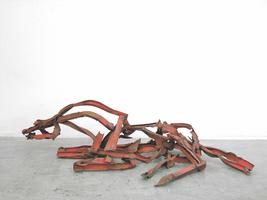 Some
of her horses appear to be made of wood, dried and bleached by water
and the sun on beaches and mountains, or from the trees and woods she
knows. But when these wooden horses are completed, they are sent off
to her foundry in Washington. Each separate wooden piece is removed
and cast in bronze, and the wooden form is burned out by the molten
bronze. The metal is then patinated to look like wood, and the pieces
are welded back together. This method allows her "wooden" horses
to be displayed in the elements, and they will last as long as any
bronze statue.
Some
of her horses appear to be made of wood, dried and bleached by water
and the sun on beaches and mountains, or from the trees and woods she
knows. But when these wooden horses are completed, they are sent off
to her foundry in Washington. Each separate wooden piece is removed
and cast in bronze, and the wooden form is burned out by the molten
bronze. The metal is then patinated to look like wood, and the pieces
are welded back together. This method allows her "wooden" horses
to be displayed in the elements, and they will last as long as any
bronze statue.
My favorite horse, the white, seven-foot-tall Isbella, is made by this bronzed-wood method. On close inspection, the components seem thrown on, haphazard, almost chaotic - a windstorm of wood suddenly halted, creating a form. But standing back, as one would with an Impressionist painting, the forms become alive to reveal the stance of a reflective horse. One can feel the little bone under the arched neck. Pieces of bronzed wood show the perfect curve of the forehead, another the long curve of the hindquarters, a rippling muscle of a back leg, the ears pointing forward and back, and the tail twitching.
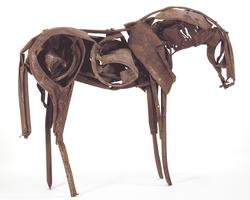 Her
horses show their own natural perfection. You can sense their
identities from the turns of their heads or the flicks of their long
tails, from the strength shown in their necks to the shapes of their
muzzles. Her works suggest the elegance and form, the energy and
moods, and the physical and the spiritual essence of each horse.
Her
horses show their own natural perfection. You can sense their
identities from the turns of their heads or the flicks of their long
tails, from the strength shown in their necks to the shapes of their
muzzles. Her works suggest the elegance and form, the energy and
moods, and the physical and the spiritual essence of each horse.
Untitled #4 seems made in layers of crushed brown aluminum foil, wrapping itself around the invisible form of a horse to describe it, as a wrapped building by Christo both describes and illuminates. The mouth seems to be chewing and the head is tilted, trying to get a good grip with the teeth. Only one familiar with horses would have remembered this moment.
The horse Billings stands looking down, made of rugged tractor parts, with pieces climbing over each other in swirls to form the hide, and a great emptiness inside, allowing for the invisible to enter.
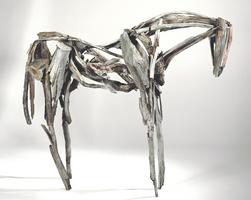 Each
of the horses shows the unadorned lower legs of the original
armature, trailing off into straight beams touching the floor. There
are no hooves. Butterfield said that portraying the hooves would add
an element that would detract from her ideas and forms.
Each
of the horses shows the unadorned lower legs of the original
armature, trailing off into straight beams touching the floor. There
are no hooves. Butterfield said that portraying the hooves would add
an element that would detract from her ideas and forms.
Looking quietly around the room is the sculpture Red Head. She's formed with flattened red railroad metal, her neck pounded and altered, her knees perfectly suggested. She stands listening for our approach. There is something beautiful and poetic about her lines and forms.
In the same room, the six-foot-tall Palma is made in metal painted in strong but faded primary colors, assembled from the metal signs that we would have seen on the old Route 66. She looks like a circus horse, multicolored and carnival-esque, something from the past history of horses or cinema. She gives the impression of entering from another time, when horses were an everyday part of life. But this one seems different, comfortable with her unique appearance, powerful and at ease.
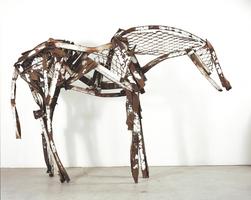 One
horse is sitting down, flattening out into a sea of driftwood. Hawaii
seems melancholic, ready to sleep, lost. Below his neck and back,
forms grow indistinct. His legs are there but only lightly suggested.
His body, made of ancient wood, seems ancient itself, like a spirit
horse melting back into the earth. We feel a sense of loss, of
something passing, a kind of old elemental sadness.
One
horse is sitting down, flattening out into a sea of driftwood. Hawaii
seems melancholic, ready to sleep, lost. Below his neck and back,
forms grow indistinct. His legs are there but only lightly suggested.
His body, made of ancient wood, seems ancient itself, like a spirit
horse melting back into the earth. We feel a sense of loss, of
something passing, a kind of old elemental sadness.
Butterfield's horses are like a kind of poem. But instead of using words to surround and describe an emotion or an experience to pass on to others, she uses pieces of metal and wood that are placed around and through the spirit of a horse.
What she captures is something that is more than just the horse. The forms she uses are rough and sometimes ugly, but they beautifully surround and give emotions that we can sense. We can feel the wonderful presence of each animal, a woman's love of her horses, and an artist's use of surprising materials to capture a living, communicating creature. It is the total effect of all these abstract forms coming together that reverberates in our minds and transforms them into the internal life of the horse.










